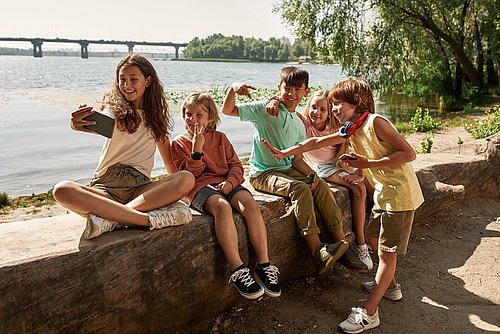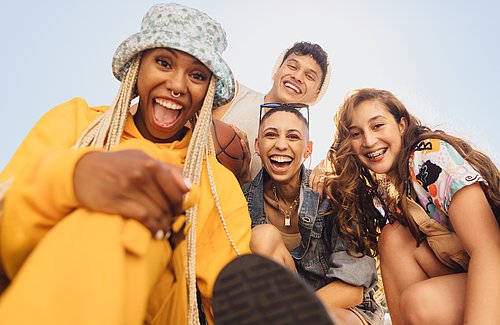
Children's marketing, We are Family, Digital Marketing, Families, Marketing Agency, Network, Social media, Young adults, Young target group, Student marketing, Gen Z, Gen Alpha
5 Proven Ways to Create and Develop the "Fun Factor" into Experiences for Young Consumers

We live in a world with an abundance of exciting things to do, and Gen Zers (age 10 to 25) and Alpha Gen (newborn to 9 years old) are on a never-ending hunt for what's new, thrilling, and popular. Plus, they have a lot of leisure time on their hands.
Young people desire to be entertained. Therefore, they place a premium on shared experiences that allow them to join in with others, improve their standing among peers, and develop as individuals (whether they are aware of it yet or not).
This article is about making social, digital, and physical interactions fun. Hopefully, it will provide you with some clarity and inspiration and boost your confidence to build more "fun" into your product, service, or other youth focused experience.
LET'S START BY DEFINING FUN
There's nothing more fundamental to a youth experience than the fun factor. An experience can have a rad aesthetic, the most kick-ass gamification engine, excellent UX, famous creators involved in the content, top production quality, and a mega marketing budget, but none of this matters if it isn't fun.
Certainly fun is something most youth-focused designers, developers, youth content producers, and marketing professionals hope their product, service or other experience delivers on.
To give context for this challenging and highly subjective topic, here's a brief rundown of what makes an experience fun or not, followed by five proven methods you and your team can put into action today.
I've divided the remainder of this section into two parts:
What is fun
What is NOT fun
WHAT IS FUN
Interaction: Playing with friends and animals, nurturing or in some cases destroying things.
Challenges: Winning a contest, giveaway, or battle, hunting and exploring, learning something new, overcoming a barrier/solving a problem, escaping, challenging others, gambling/betting.
Community: Joining a fandom, making friends, meeting interesting people/characters, status/bragging rights, playing with friends, and competitive rankings.
Emotional: Looks cool, humor/comedy, surprises, showing support for other, fantasies, gaining access, having powers, feelings of nostalgia, sense of completion, being in on secrets, exploration, and discovery, giving and receiving compliments, winning, getting away with something, good music, good food, and earning rewards.
WHAT IS NOT FUN
Of course, it's critical to understand what works, but equally crucial is knowing what not to do.
Here are a few things we strive to avoid:
Expecting young people to do a lot of one activity without receiving positive reinforcement, having to struggle too hard, unreasonable delays, technical glitches, lengthy load times, perplexing/difficult experiences, anything long and boring, bad imitations of something good, too much losing, a game or content narrative that is too difficult to understand, not having the ability to skip forward, unimaginative storytelling, negative talk, bad parodies, anything fake, horrible actors/talent, clickbait that sends you somewhere you don't want to go or learn about, and anything with too much repetition.
5 WAYS TO BUILD THE "FUN FACTOR" INTO YOUTH EXPERIENCES
1. CLEARLY DEFINE WHAT CONSTITUTES "FUN" FOR YOUR TARGET AUDIENCE AND THE TYPE OF EXPERIENCE YOU ARE CREATING.
The process starts by developing a thorough and well-written experience design brief that defines the fun factors as criteria for success (draw from the examples listed above).
No amount of slack posts, emails, text messages, presentations, conversations, or meetings should ever replace the experience design brief.
Describe your definition of fun in a way that clearly communicates the what, how and why.
Example: How LEGO defines fun
"Fun is the happiness builders experience when they are fully engaged in creating something that requires mastery and their abilities are in balance with the challenge at hand."
Next, define the type of experience/s your team will be exploring.
2. FORM THE RIGHT TEAM TO DEVELOP THE TYPE OF FUN FACTORS IN YOUR EXPERIENCE DESIGN BRIEF.
To create fun in a commercially viable way, you will need a team capable of developing the type of fun experiences you are seeking.
Start by assessing if you have the right people by evaluating their passion for the work, technical skills for the experience development, creativity, collaboration abilities, and expertise in the target market/culture/activity.
Here are a few example questions to consider as you evaluate talent:
Does the person have experience developing a similar "fun" experience in your industry?
Does the audience or industry already respect this person? If yes, does that matter?
Does the person understand the targeted youth audience, genre, key trends, and various nuances associated with the experience to be developed?
Does this person share a passion for this type of youth culture experience?
3. CO-CREATE THE EXPERIENCE WITH STRATEGICALLY SELECTED YOUTH PARTICIPANTS
The approach to creative collaboration can make or break your capability to develop the style of fun you are seeking. That's why a well-designed process should be an investigatory roadmap, with consistent checks and balances to help your team stay on course or pivot when needed. In addition, youth-focused experience design needs to capture Gen Z and/or Alpha Generation opinions and preferences that may not surface with traditional research methods alone.
Best practices for co-creation with Gen Z and Alpha Generation:
Involve a range of young enthusiasts, subject matter experts and influencers; including both extroverts and introverts. In some cases individuals who typically dislike the type of fun experience you are developing may help round out the group.
Participant group size ranges: 5-7, 10-15, 25-50
Duration: 3, 6, or 12 months with change-outs
Incentives: special access (to product, service, other), gift cards, financial compensation
Determine if you will be co-creating the concept or defining areas of uncertainty and framing a hypothesis (or hypotheses), then building out a minimum viable experience for testing these area(s) of focus.
Create tasks and instructions that are appropriately designed for the life stage and experience level of youth participants.
Leverage mobile-video-based platform for remote co-creation projects.
Launch your co-creation group with an informative yet casual welcome video.
Start the process by posting discussion topics related to the project to get to know each member, build community and spark creativity.
Each week, post an activity on Monday for the members to do independently by the following Sunday.
Send the participants a notification for the activity and post it to the group.
Each activity should have a page or video that walks the participant through the activity steps and stores their responses (text/videos) privately and confidentially.
During the week, post a few discussion prompts to encourage group discussion related to the activity (if applicable). These prompts are used to create dialogues that probe deeper into the topics, ideas, themes, and trends from the weekly exercises.
Allow extra time if physical items need to be delivered to participants.
Ensure each weekly exercise is designed to ideate or dive deeper into ideas that inform, inspire, course correct, or validate the direction for your experience design.
Most importantly, make the procedure of co-creating a pleasure to participate in and have FUN!
4. DEVELOP & MAINTAIN A FUN YOUTH EXPERIENCE
The key challenge when co-creating with youth audiences is how to keep the audience engaged for the desired duration of the experience once you've overcome the obstacle of making it enjoyable.
Here’s a quick and effective way to assess how "fun and compelling" the experience is. Have your team reflect on the following line of questioning throughout the development process:
Is it easy to understand for young people?
Can young people lose themselves in it?
Is it fresh and exciting for young people? Does it startle, amaze, agitate or amaze them?
Can young people try it without reading a manual? Can they get it to do what you want?
Does it make you remember, connect, think, grow?
Does it make young people feel different? Do they have something to show for it?
5. TEST/REFINE/REPEAT
For this point, the title speaks for itself.
Developing fun experiences for the Alpha Generation and Gen Z youth is an ongoing and iterative process.
It requires a framework to achieve your objectives, speed, and agility to stay ahead of the curve, yet enough space for creativity, evaluation, and innovation to take shape.
In what ways do you build “fun factors” into youth experiences? Did I include them in the list?


